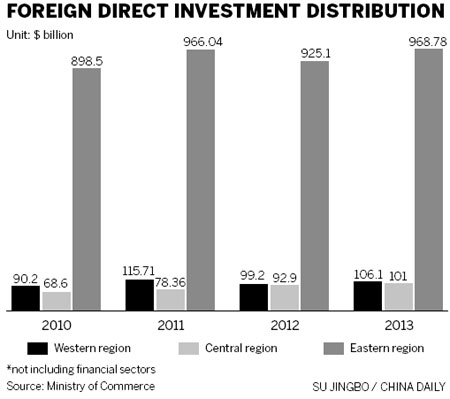Global investors shift their focus inland
China Daily, February 14, 2014 Adjust font size:

|
The Yingkoumen overpass is seen under construction in 2013 in Chengdu, capital of Sichuan province in western China. [China Daily] |
Key hub
"We're building China into one of the key innovation and operation hubs of Philips Global for value creation, a hub with both global reach and influence," Kong said.
Philips China announced its "Go West" strategy in 2011, in line with the Chinese government's Western Region Development strategy. The company's move was intended to improve service to customers in the broader area of Central and West China, Kong said.
In June 2011, Philips announced that it would set up a second Chinese headquarters in Chengdu. The purpose was to leverage its strength in innovation and its advantages in the fields of health, lighting and consumer lifestyle while creating a business model fitting the local market.
"We are developing a '2017 strategy' that establishes a new blueprint for the next five years to ensure the sustainable development of Philips China. 'Go West' will assume a more important strategic position.
"We are accelerating innovation in China and for China, aiming to deliver more meaningful innovations to Chinese customers not only in the western region but across the country," Kong said.
DuPont Greater China President Tony Su said: "We see great growth potential in Chengdu because it is one of the fastest-growing cities in southwest China. Also it has great advantages in infrastructure, business environment and talent."
He noted that Sichuan is a large province in West China in terms of population, resources and economic development.
Its advantages in the high-end materials industry, resources, industrial bases, R&D capabilities and manpower support made it an important economic and industrial base in the "Go West" initiative.
Commercial upside
Chengdu has advantages in terms of commercial operations and market prospects, comparable to similar cities in eastern China. The city also has outstanding universities, such as Sichuan University and the Chengdu University of Electronic Science and Technology, and thus it holds advantages in R&D capabilities and human resources, according to Su.
"From DuPont's perspective, there are many collaboration opportunities with local enterprises in various businesses in Sichuan and the western region," Su said.
In August 2012, DuPont opened its Chengdu branch office, a milestone in the growth of DuPont China. The business in the region has been growing rapidly in recent years because of the favorable business environment and support by the government at all levels, he added.
"We plan to establish two innovation centers in China in the 2014-2015 timeframe, one in western China," Su said.
"These centers will be platforms for collaboration. By working with our local partners and connecting them to our global science network, we can better exchange ideas and create an inclusive atmosphere that generates innovative solutions.
"Establishing an innovation center in western China, we are committed to partnering with local stakeholders to get more tailor-made products into the market place, at a much faster rate, to support local growth."
Xiong Wei, vice-president of Siemens Ltd China, said the "Western Development" policy was apparently laying the groundwork to give the region wider influence and improved competitiveness.
Competitiveness is being increased with better urban infrastructure and the constant optimization and upgrading of industries.
Talent pool
"The western region has very important hub cities with great development potential, such as Chengdu and Chongqing, where there's a large talent pool and a high concentration of universities and research institutes.
"Human resources have drawn Siemens to invest in the western region. Also, the livability of the western region has meant a stable pool of talented workers. It makes the region more attractive for talent," Xiong said.
Last year, Siemens Electronics Works Chengdu, the company's first overseas digital enterprise, started operations in the Chengdu High-tech Zone. Government support, human resources, logistics and infrastructure provided a sound environment for the digital enterprise to take root in the western region.
"The western region is a key market for Siemens in China, offering great development potential under the nation's 'Western Development' strategy. The government has ambitious plans that call for the economic reconstruction of Western China," Xiong said.
He said that a favorable environment for innovation will be a very important factor in the ongoing improvement of the region's investment environment.
The priority for any enterprise to develop well in the region is to maintain advanced innovation capability, keep up with the local market and develop products and solutions that really meet the demands of local customers.
Better links
Chen Fu, deputy director-general of Chengdu Investment Promotion, a government agency, said that the city has markedly improved its infrastructure in recent years.
Greater Chengdu has a consumer market of 300 million people. It also has flights to a range of international cities, including London, Melbourne and Amsterdam.
The city last year opened a rail cargo link to Europe that connects the western region with Lodz, Poland, with a shorter transit time.
The municipal government late last year introduced the 72-hour visa-free services for the citizens of 51 countries, which "will provide competitive and convenient conditions for foreign travel traders to come to Sichuan to undertake investigations and project negotiations", according to Chen.
As of Dec 31, there were 252 companies from the Fortune Global 500 list doing business in Chengdu.
Foreign direct investment in the city surged 27.8 percent year-on-year to $9.86 billion in the January-November 2013 period, according to the municipal government.
China's western region has drawn increasing FDI in recent years. In 2013, FDI in the western region reached $10.6 billion, up 6.96 percent, compared with the national figure of 5.25 percent, according to the Ministry of Commerce.


